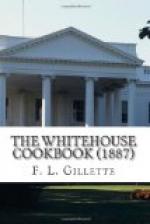SUGAR GRAINS, COLORED.
Stir a little coloring—as the essence of spinach, or prepared cochineal, or liquid carmine, or indigo, rouge, saffron, etc.,—into the sugar grains made as above, until each grain is stained, then spread them on a baking-sheet and dry them in a warm place. They are used in ornamenting cake.
CARAMEL OR BURNT SUGAR.
Put one cupful of sugar and two teaspoonfuls of water in a saucepan on the fire; stir constantly until it is quite a dark color, then add a half cupful of water and a pinch of salt; let it boil a few minutes and when cold, bottle.
For coloring soups, sauces or gravies.
TO CLARIFY JELLY.
The white of egg is, perhaps, the best substance that can be employed in clarifying jelly, as well as some other fluids, for the reason that when albumen (and the white of egg is nearly pure albumen) is put into a liquid that is muddy, from substances suspended in it, on boiling coagulates in a flocculent manner, and, entangling with the impurities, rises with them to the surface as a scum, or sinks to the bottom, according to their weight.
CONFECTIONERY
In the making of confections the best granulated or loaf sugar should be used. (Beware of glucose mixed with sugar.) Sugar is boiled more or less, according to the kind of candy to be made, and it is necessary to understand the proper degree of sugar boiling to operate it successfully.
Occasionally sugar made into candies, “creams” or syrups, will need clarifying. The process is as follows: Beat up well the white of an egg with a cupful of cold water and pour it into a very clean iron or thick new tin saucepan, and put into the pan four cupfuls of sugar, mixed with a cupful of warm water. Put on the stove and heat moderately until the scum rises. Remove the pan, and skim off the top, then place on the fire again until the scum rises again. Then remove as before, and so continue until no scum rises.
This recipe is good for brown or yellowish sugar; for soft, white sugars, half the white of an egg will do, and for refined or loaf sugar a quarter will do.
The quantities of sugar and water are the same in all cases. Loaf sugar will generally do for all candy-making without further clarification. Brown or yellow sugars are used for caramels, dark-colored cocoanut, taffy, and pulled molasses candies generally.
Havana is the cheapest grade of white sugar and a shade or two lighter than the brown.
Confectioners’ A is superior in color and grain to the Havana. It is a centrifugal sugar—that is, it is not re-boiled to procure its white color, but is moistened with water and then put into rapidly-revolving cylinders. The uncrystalized syrup or molasses is whirled out of it, and the sugar comes out with a dry, white grain.




